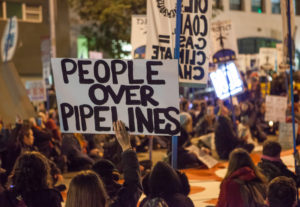The U.S. Government Just Approved an Enormous Oil Pipeline
It took seven years of organizing to stop the Keystone XL pipeline from being built up and down the U.S. -- and now a new mega-pipeline “has quietly received full regulatory permission to begin construction." Giant steel pipes ready for use in an unspecified pipeline. (naturalflow / CC BY-SA 2.0)
Giant steel pipes ready for use in an unspecified pipeline. (naturalflow / CC BY-SA 2.0)
Giant steel pipes ready for use in an unspecified pipeline. (naturalflow / CC BY-SA 2.0)
It took seven years of organizing to stop the Keystone XL oil pipeline from being built up and down the U.S. — and now a new mega-pipeline “has quietly received full regulatory permission to begin construction,” reports Mother Jones.
MJ’s Alexander Sammon reports of the Dakota Access Pipeline Project:
Known also as the Bakken Pipeline, the project is slated to run 1,172 miles of 30-inch diameter pipe from North Dakota’s northwest Bakken region down to a market hub outside Patoka, Illinois, where it will join extant pipelines and travel onward to refineries and markets in the Gulf and on the East Coast. If that description gives you déjà vu, it should: The Bakken Pipeline is only seven miles shorter than Keystone’s proposed length.
The $3.78 billion project is being built by Dakota Access, LLC, a unit of the Texas-based Energy Transfer Partners. (Former Texas Gov. Rick Perry, a friend of Iowa Gov. Terry Branstad, sits on ETP’s board.) According to the firm, the Bakken Pipeline will transport up to 570,000 barrels of crude oil per day. Advocates have celebrated the supposed 12,000 jobs the pipeline will create in construction, while repeating calls to end American dependence on foreign oil—a platform called into question by new laws allowing US producers to export crude. The US Army Corps of Engineers gave its blessing at the end of July, clearing the final hurdle for the massive infrastructure project, which is slated to be operational by the fourth quarter of 2016.
How many jobs will the pipeline produce?
According to Dakota Access’s DAPL fact sheet, the pipeline will create 8,000 to 12,000 construction jobs. An earlier draft of those figures claimed 7,263 “job-years” to be created in Iowa alone. Not so fast, says professor David Swenson, associate scientist in the Department of Economics at Iowa State University. Swenson crunched the numbers himself and came to a much more modest conclusion: 1,500 jobs total per year in Iowa for the course of construction. And given that most of these jobs are skilled, Swenson expects many of the hires will be from out of state, as Iowan contractors specializing in large-scale underground pipe-fitting and welding are scarce. The long-term forecast for job creation is even bleaker. The Des Moines Register reports that there will only be 12 to 15 permanent employees once the pipeline is completed. (DAPL has since walked back its job estimate slightly.)
And what are the odds of an environmentally disastrous spill?
As Sierra Club’s Michael Brune puts it, “It’s not a question if a pipeline will malfunction, but rather a question of when.” And, though they spill less often than trains do, the International Energy Agency found that pipelines spill much more in terms of volume—three times as much between 2004 and 2012. The Bakken Pipeline’s route takes it through active farmland, forests, and across the heartland’s major rivers: The Big Sioux, the Missouri, and the Mississippi, some with multiple crossings, though the US Fish and Wildlife Service claims that no “critical habitat” is endangered. It also runs through sacred Native American lands (more on this below).
—Posted by Alexander Reed Kelly.
Your support matters…Independent journalism is under threat and overshadowed by heavily funded mainstream media.
You can help level the playing field. Become a member.
Your tax-deductible contribution keeps us digging beneath the headlines to give you thought-provoking, investigative reporting and analysis that unearths what's really happening- without compromise.
Give today to support our courageous, independent journalists.






You need to be a supporter to comment.
There are currently no responses to this article.
Be the first to respond.